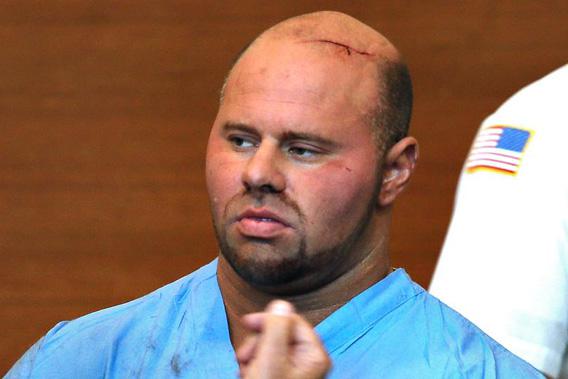As with most men who allegedly commit domestic homicide, Jared Remy—son of broadcaster and former Boston Red Sox player Jerry Remy, and himself a Red Sox security guard until he was fired for steroid use in 2008—gave everyone lots of warning. When he was arrested Thursday night on charges of stabbing his girlfriend, Jennifer Martel, to death in front of their 4-year-old daughter and neighbors, it was only one day after he had been brought in front of Waltham District Court in Massachusetts on charges of slamming Martel’s face into a mirror—and was then released. Despite 14 previous arrests, including domestic violence against two other women, Remy was allowed to walk free without bail—just a paper-thin order to not abuse Martel. The next night he, in the words of Martel’s mother, “went back and finished the job.”
This all happened despite the option, recently highlighted in a New Yorker piece, that exists in Massachusetts to hold high-risk offenders in jail for a period of time, after a “dangerousness hearing,” to prevent them from doing things like murdering their victims. So what went wrong here?
Part of the problem is an old and frequent one: The victim’s lack of cooperation appears to have allowed prosecutors to lull themselves into believing Remy wasn’t that big of a threat. Martel did not come in to renew the emergency restraining order that had been put on Remy. Martel’s family told the Boston Globe that Martel backed off due to pressure coming from Remy’s mother, “who begged her not to file any kind of complaint because it would ruin Remy’s life.” Prosecutors have confirmed that Martel’s unwillingness to get a restraining order was a major factor:
Officials with the Middlesex prosecutor’s office would not discuss whether they considered pursuing a dangerousness hearing. They did, however, say their conversations with Martel were a prominent factor in how they pursued charges against Remy.
“We had conversations with [Martel] about what her wishes were, and she expressed to us that she was not coming [to ask for a new restraining order],” Long said.
However, as critics point out, a dangerousness hearing doesn’t require the victim’s cooperation, though that cooperation does dramatically improve the chances that a judge will decide to hold an abuser. Suzanne Dubus, the CEO of the Jeanne Geiger Crisis Center, which was profiled in that New Yorker piece for its innovative work in domestic homicide prevention, told me Monday morning that although her team isn’t privy to the facts in this particular case, “We know from research that the period after arraignment is one of the most dangerous times for victims of domestic violence,” and that dangerousness hearings should be strongly considered for many cases.
Dubus works closely with the Massachusetts high-risk assessment team, a government-funded program that ties law enforcement and social services together to determine if an offender is in danger of escalating and takes steps to prevent that from happening. The team covers much of Massachusetts, but not Waltham, where Remy abused Martel. What might have happened had Remy been in the team’s jurisdiction? “A few things we have learned is that on-scene risk assessment by law enforcement is critical, as that is the information given to prosecution to build their case,” Dubus explains. It’s impossible to know what would have happened had there been an on-scene assessment when Remy slammed Martel into that mirror, but certainly he had many of the red flags that the high-risk team takes into account when making its determinations, including employment problems and a serious past of domestic violence.
Still, even with a high-risk assessment team on hand and much more pressure on law enforcement officials to use the dangerousness hearing and strategies like GPS trackers on abusers to keep them away from their victims, without a victim willing to file a restraining order, it can be hard for prosecutors to make the case that a man is dangerous. This is why interventions aimed at victims, something that the high-risk assessment team includes in its responses, can be so critical in preventing future violence. A 2003 study of 11 cities found that about half of victims of successful or attempted domestic murders did not believe their partners capable of murder. In response, many states such as Maryland have created programs where victims of domestic violence are given a checklist that not only helps law enforcement determine how dangerous the abuser is but can also help a victim in denial see how much danger her abuser presents to her—and therefore help convince her to be more cooperative with efforts to restrain him.
Interventions such as victim counseling, on-scene risk assessment, and more aggressive use of dangerousness hearings to keep abusers away from their victims can’t stop all crimes like Jared Remy’s. Some men will slip through the cracks, and some victims will be so recalcitrant that it makes it nearly impossible to push forward with prosecution. Still, Remy’s history and the very few obstacles in his path to murder should serve as a reminder of how important these interventions really are. Not all men like Remy can be stopped by thorough law enforcement and social service interventions, but some can, which is a start.
